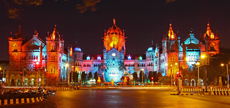|
 |
|
The Chhatrapati Shivaji Terminus (CST)
in Mumbai, the headquarters of Central Railway, which turns 60
on Saturday.
(Photo: IANS) |
Mumbai: Steeped in rich
history synonymous with the development of Mumbai as the country's
commercial capital, the Central Railway, headquartered here but
catering to a large part of the country, turns 60 Saturday.
It was on Nov 5, 1951 that Central Railway was formed by
integrating the railways of the erstwhile princely domains - Nizam
State, Scindia State and Dholpur State - with the then Great
Indian Peninsular Railway.
However, technically speaking, the Indian Railways history started
158 years ago - April 16, 1853 - in an epoch-making event in the
entire East.
"It was 3.30 p.m. on that day (April 16, 1853), when the new
railway system was launched in Bombay (now Mumbai). A sea of
humanity thronged Bori Bunder Station, to witness history in the
making when a small train hauled by three steam engines started
for its historic journey to Thane," an official told IANS.
The day was declared a public holiday and a festive atmosphere
prevailed among the small fishing communities on the small islands
that made up Bombay.
There were bands which played and guns were fired from the
ramparts of the Fort area, barely half a kilometre to the south of
the station, heralding the dawn of the Railway Era to the whole
world.
Over the years, Bori Bunder became Victoria Terminus and now
Chhatrapati Shivaji Terminus (CST), and the GIPR also grew in
leaps and bounds by expanding its network all over the country -
laying the foundations for making the railways the most
convenient, efficient and affordable means of travel for a
majority of Indians even today.
The then Indian Midland Railway Company was merged with the GIPR
in 1900 and its frontiers were extended to Delhi in the North,
Kanpur and Allahabad in the North-east, Nagpur in the West and
Raichur in the South-east.
With a route mileage of 1,600 miles (2,575 km), this network
enabled comfortable through-connections from Bombay to virtually
all parts of India, underlining the importance of the city in
every sphere of life.
Later, after Independence, the CR was formed in 1951, along with
other divisional railways. Over the years, the developmental
process continued with the CR growing in a big way, both in terms
of long-distance services and an efficient suburban network.
In October 1966, one more railway viz. South Central Railway (SCR)
was formed by merging Solapur Division from CR and Secunderabad,
Hubli, Vijayawada Divisions from Southern Railways.
On Oct 2, 1977, Solapur Division was merged with CR and Guntakal
Division from SR was included in SCR.
Later, in 2003, seven more railway zones were created in which
Jabalpur and Bhopal divisions of CR were included in the West
Central Railway and Jhansi Division was included in North Central
Railway.
Presently, CR has five divisions - Mumbai, Pune, Bhusaval, Solapur
and Nagpur - with a network of 477 stations, and a whopping 710
mail, express and passenger trains running on it daily.
The railways have not only enriched the country's life in
different ways - culturally, socially, economically and
politically - but also contributed in a big way to the national
exchequer.
In 1951, when it was formed, CR earned a modest Rs.18.64 crore
from passengers, which now stands at Rs.3,079.25 crore per annum.
Similarly, its earnings from freight have grown from Rs.24.98
crore to Rs.3,889.56 crore.
Starting with 224 million passengers and 16.58 million tonnes
freight in 1951, it now carries 1,628 million passengers and 54.75
million tonnes freight.
Its original route, which was 8,734 km has now come down to 3,905
with the re-organisation of the divisions over the years.
On the suburban section catering mainly to Mumbai, it had 519
services daily, which has now touched 1,573 services - the
combined suburban section of the Western Railway and CR carry over
seven million passengers daily, making it the city's lifeline.
A few years ago, the CR headquarters building was accorded a World
Heritage status. Three years ago, it shot into international
headlines when it was a targeted site by Pakistani gunmen in the
Nov 26, 2008 terror attacks.
|



















